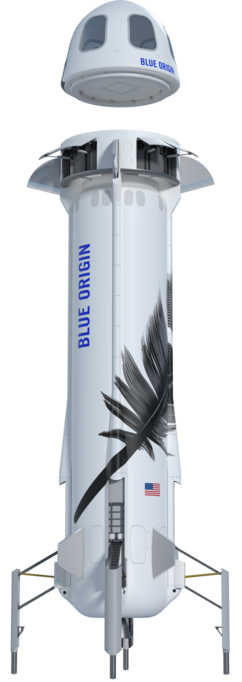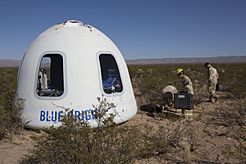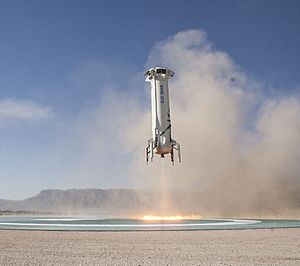New Shepard facts for kids
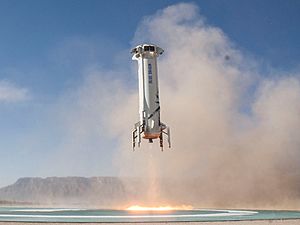 |
|
| Manufacturer | Blue Origin |
|---|---|
| Country of origin | United States of America |
| Size | |
| Height | 18m (60ft) |
| Diameter | 3.7m (12.1ft) |
| Mass | |
| Stages | 1 |
| Launch history | |
| Status | Active |
| Launch sites | Launch Site One |
| Total launches | 23 |
| Successes | 22 |
| Failures | 1 |
| Landings | 21 |
| First flight | 29 April 2015 |
| Single stage | |
| Engines | 1 BE-3 |
| Thrust | 110,000 lbf (490 kN) |
| Burn time | 141 seconds |
| Fuel | LH2 / LOX |
New Shepard is a fully reusable sub-orbital launch vehicle developed for space tourism by Blue Origin. The vehicle is named after Alan Shepard, who became the first American to travel into space and the fifth person to walk on the Moon. The vehicle is capable of vertical takeoff and landings. Additionally, it is also capable of carrying humans and customer payloads into a sub-orbital trajectory.
New Shepard consists of a booster rocket and a crew capsule. The capsule can be configured to house up to six passengers, cargo, or a combination of both. The booster rocket is powered by one BE-3PM engine, which sends the capsule above the Kármán line, where passengers and cargo can experience a few minutes of weightlessness before the capsule returns to Earth.
The launch vehicle is designed to be fully reusable, with the capsule returning to Earth via three parachutes and a solid rocket motor. The booster lands vertically on the same launchpad it took off from. The company has successfully launched and landed the New Shepard launch vehicle 22 times with 1 partial failure deemed successful and 1 failure. The launch vehicle has a length of 15.0 m, a diameter of 3.7 m and a launch mass of 75 T. The BE-3PM engine produces 490 kN of thrust at liftoff.
Contents
History
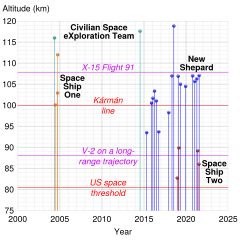
The first development vehicle of the New Shepard development program was a sub-scale demonstration vehicle named Goddard that was built in 2006 following earlier engine development efforts by Blue Origin. Goddard made its first flight on 13 November 2006. The Goddard launch vehicle was assembled at the Blue Origin facility in Kent, Washington, United States. The test vehicle named Goddard (also known as PM1) that first flew on November 13, 2006. The flight was successful. A second test flight was scheduled for December 2 which never took place.
According to Federal Aviation Administration records, two further flights were performed by Goddard. Blue Engine 1, or BE-1, was the first rocket engine developed by Blue Origin and was used in the company's Goddard development vehicle. On the path to developing the New Shepard launch vehicle, a crew capsule was also needed, and design was begun on a space capsule in the early 2000s. One development milestone along the way became public. On 19 October 2012, Blue Origin conducted a successful pad escape of a full-scale suborbital crew capsule at its West Texas launch site. For the test, the capsule fired its pusher escape motor and launched from a launch vehicle simulator. The Crew Capsule traveled to an altitude of 2,307 ft (703 m) under active thrust vector control before descending safely by parachute to a soft landing 1,630 ft (500 m) downrange.
In April 2015, Blue Origin announced that they had completed acceptance testing of the BE-3PM engine that would power the New Shepard launch vehicle. The company also announced that they intended to begin flight testing of the New Shepard later in 2015, with initial flights occurring as frequently as monthly, with "a series of dozens of flights over the extent of the sub-orbital test program [taking] a couple of years to complete". The same month, the FAA announced that the regulatory paperwork for the test program had already been filed and approved, and test flights were expected to begin before mid-May 2015. By February 2016, three New Shepard vehicles had been built. The first was lost in a test in April 2015, the second had flown twice (see below), and the third was completing manufacture at the Blue Origin factory in Kent, Washington, United States. In 2016, the Blue Origin team were awarded the Collier Trophy for demonstrating rocket booster reusability with the New Shepard human spaceflight vehicle.
On July 20, 2021, the company successfully completed its first crewed mission, Blue Origin NS-16, into space using its New Shepard launch vehicle. The flight was approximately 10 minutes and crossed the Kármán line. New Shepard performed six crewed flights between July 2021 and August 2022, taking a mix of sponsored celebrities such as Wally Funk, William Shatner as well as paying customers. New Shepard ticket sales brought in $50 million through June 2022. On July 20, 2021, the New Shepard performed its first crewed mission into space. The flight lasted approximately 10 minutes and crossed the Kármán line. The passengers were Jeff Bezos, his brother Mark Bezos, Wally Funk, and Oliver Daemen. The second and third crewed missions of New Shepard took place in October and December 2021. The Fourth crewed flight happened in March 2022. On June 4, 2022, New Shepard completed its fifth crewed mission launch and the sixth crewed flight took place on August 4, 2022. In September 2022, an uncrewed mission of the New Shepard had an anomaly due to a failure of the BE-3PM main engine. The launch escape system triggered and the capsule landed safely. The remaining New Shepard launch vehicles were grounded pending an FAA investigation into the incident. After a six-month investigation, Blue Origin pinpointed the cause of the anomaly as a thermal-structure failure of the BE-3PM engine nozzle caused a thrust misalignment that triggered the capsule's emergency escape system to activate. Blue Origin said in its press release that New Shepard flights would resume as soon as possible.
New Shepard vehicles
New Shepard 1
The first flight of the full-scale New Shepard vehicle was NS1, also called "Tail 1" and was conducted on 29 April 2015 during which an altitude of 93.5 km (58.1 mi) was attained. While the test flight itself was deemed a success, and the capsule was successfully recovered via parachute landing, the booster crash landed and was not recovered due to a failure of hydraulic pressure in the vehicle control system during descent. The capsule was called RSS Jules Verne.
New Shepard 2
The New Shepard 2 (NS2), also called "Tail 2", flight test article propulsion module made five successful flights in 2015 and 2016, being retired after its fifth flight in October 2016.
New Shepard 3
New Shepard 3 (NS3), also called "Tail 3", along with capsule RSS H. G. Wells, was modified for increased reusability and improved thermal protection; it includes a redesigned propulsion module and the inclusion of new access panels for more rapid servicing and improved thermal protection. NS3 is the third propulsion module built. It was completed and shipped to the launch site by September 2017, although parts of it had been built as early as March 2016. Flight tests began in 2017 and continued into 2019. The new Crew Capsule 2.0, featuring windows, is integrated to the NS3. NS3 will only ever be used to fly cargo; no passengers will be carried.
Its initial flight test occurred on 12 December 2017. This was the first flight flown under the regulatory regime of a launch license granted by the US Federal Aviation Administration. Previous test flights had flown under an experimental permit, which did not allow Blue Origin to carry cargo for which it is paid for commercially. This made the flight of NS3 the first revenue flight for payloads, and it carried 12 experiments on the flight, as well as a test dummy given the moniker "Mannequin Skywalker."
Since the maiden flight, "Blue Origin has been making updates to the vehicle ... intended primarily to improve operability rather than performance or reliability. Those upgrades took longer than expected" leading to a several-month gap in test flights. The second test flight took place on 29 April 2018. The 10th overall New Shepard flight, and the fourth NS3 flight, had originally been planned for December 2018, but was delayed due to "ground infrastructure issues." Following a diagnostics of the initial issue, Blue Origin rescheduled the launch for early 2019, after discovering "additional systems" that needed repairs as well. The flight launched on 23 January 2019 and successfully flew to space with a maximum altitude of 106.9 km (66.4 mi). It has been used to test SPLICE ("Safe and Precise Landing – Integrated Capabilities Evolution"), a NASA lunar landing technology demonstration, on two separate flights in October 2020 (NS-13) and August 2021 (NS-17).
New Shepard 3 booster was destroyed during the NS-23 mission once it impacted the ground on 12 September 2022 after a booster engine anomaly led to the activation of the in-flight abort system. The capsule made a successful landing under parachutes. This was the ninth flight of NS3, and the flight was not carrying any people on board.
New Shepard 4
New Shepard 4 (NS4), also called "Tail 4", which flies with capsule RSS First Step, was the fourth propulsion module to be built and the first to carry human passengers. Bezos himself was a passenger. The vehicle was manufactured in 2018 and moved to the Blue Origin West Texas launch facility in December 2019. The uncrewed maiden launch of NS4 occurred on 14 January 2021. NS4 was successfully launched on 20 July 2021, with four passengers; Jeff Bezos was aboard this maiden crewed flight. On 13 October 2021, NS4 successfully launched and landed, carrying four passengers, including notable passenger William Shatner. On 11 December 2021, the Blue Origin NS-19 successfully launched into space. The ship's passengers included NFL legend and television personality Michael Strahan, Alan Shepard's daughter Laura Shepard Churchley, who flew into space 60 years after her father's flight, and four other people. This was the first time New Shepard carried six passengers, the full design passenger complement. The fourth crewed flight took place 31 March 2022, with a Blue Origin employee and five other passengers on board. The fifth crewed flight took place 4 June 2022, and the sixth crewed flight took place 4 August 2022.
Crewed flights
Blue Origin commenced the first flight carrying passengers on the 16th flight of New Shepard (NS-16) on 20 July 2021. One commercial seat was auctioned on 12 June 2021 for $28 million which went to Blue Origin's foundation, Club for the Future, which inspires future generations to pursue careers in STEM. However, due to scheduling problems, the $28 million auction winner did not participate in the NS-16 flight. The $28 million auction winner was rescheduled to fly at a later flight.
- The passengers aboard the NS-16 flight on 20 July 2021 were Jeff Bezos, Mark Bezos, Wally Funk and Oliver Daemen. At 82 years old Funk was the oldest person, and at 18 Daemen was the youngest, to travel into space. Daemen got the commercial seat that the $28 million auction winner did not use. Daemen's flight was paid for by his father Joes Daemen, who, after the anonymous $28 million auction winner dropped out of the flight, was able to secure the seat on the flight due to being the second highest bidder on the auction. Joes paid for the seat and gave it to his son, thus making Oliver Daemen the first commercial passenger of New Shepard. On December 22, 2021, it was made public that the $28 million mystery auction winner was Justin Sun, a Chinese cryptocurrency entrepreneur. The $28 million he bid was paid to Blue Origin, who in turn gave it to their charity Club for the Future, which in turn distributed most of the money to other space-related nonprofit organizations. Instead of flying on the flight in July 2021 to which he won the auctioned seat, Sun has agreed with Blue Origin to Sun buying (presumably with the $28 million that has already been paid to Blue Origin) a dedicated New Shepard flight in 2022. Sun will choose five passengers to accompany him on this flight in late 2022.
- The second crewed flight took place on 13 October 2021, carrying four passengers, two of whom were paying passengers. The flight included the actor William Shatner who flew as "guest" of Blue Origin (i.e., he did not pay for his flight).
- On 11 December 2021, the third crewed flight, Blue Origin NS-19, successfully launched into space. The ship's passengers included NFL legend and television personality Michael Strahan and Alan Shepard's daughter Laura Shepard Churchley as "guests" of Blue Origin (i.e., they did not pay for their flights), and four other people who were paying passengers.
- The fourth crewed flight, Blue Origin NS-20, flew successfully on 31 March 2022. Onboard was Gary Lai, a Blue Origin employee and five paying passengers. This was the first flight with no celebrity passengers.
- The fifth crewed flight, Blue Origin NS-21, flew successfully on 4 June 2022. Onboard was educational YouTuber Katya Echazarreta, whose flight had been partly sponsored by Blue Origin, and partly by other sources, and five other paying passengers (it could be that it has been mistakenly claimed that Echazarreta's flight was sponsored by Blue Origin and instead it was fully sponsored by Space for Humanity, a nonprofit organization). Also onboard was Blue Origin's first repeat customer for New Shepard launches, Evan Dick.
- The 6th crewed flight took place 4 August 2022. Among the passengers was Coby Cotton, one of the founders of the popular YouTube channel Dude Perfect. His flight was paid for by the organization MoonDAO, which works in cryptocurrency to "decentralize access to space", and bought two seats from Blue Origin. One of the seats was used by Cotton and one to be used in the future by Kejun Yan. It was reported that MoonDAO had paid about $2.5 million for the two seats on Blue Origin flights, or $1.25 million per seat. This is the first public figure available for the price to ride a Blue Origin rocket to suborbital space (not counting the $28 million winning bid in the auction for a seat on the first flight). However, Blue Origin does not charge all their passengers the same price, but tailors the price individually to each passenger, so it is hard to define the "ticket price" for New Shepard. Also on the 4 August 2022 flight were the first space travellers of Egyptian and Portuguese origin, and the flight was the first flight (it may have been that the previous flight Blue Origin NS-21 on 4 June 2022 was actually the first such flight, if Katya Echazarreta's flight was not sponsored by Blue Origin, see above) where all six passengers were paying passengers (i.e., their flights were financed by other entities than Blue Origin). In 2023, rocket Scientist Aisha Bowe will be the first Black woman to fly with Blue Origin on the New Shepard rocket.
As of June 2022, the company has generated more than $100M from the New Shepard space tourism program.
Flight list
| Launch No. | Date | Vehicle | Apogee | Outcome | Notes |
|---|---|---|---|---|---|
| 0 | 19 October 2012 |
|
0.7 km (0.4369 mi) | Success | Pad abort test of the New Shepard crew capsule. |
| 1 | 29 April 2015 |
|
93.5 km (58.1 mi) | Partial success | Flight to altitude 93.5 km, capsule recovered, booster crashed on landing, Deemed successful. |
| 2 | 23 November 2015 |
|
329,839 ft (100.535 km; 62.4695 mi) | Success | Sub-orbital spaceflight and landing. |
| 3 | 22 January 2016 |
|
333,582 ft (101.676 km; 63.1784 mi) | Success | Sub-orbital spaceflight and landing of a reused booster. |
| 4 | 2 April 2016 |
|
339,178 ft (103.381 km; 64.2383 mi) | Success | Sub-orbital spaceflight and landing of a reused booster. |
| 5 | 19 June 2016 |
|
331,501 ft (101.042 km; 62.7843 mi) | Success | Sub-orbital spaceflight and landing of a reused booster: the fourth launch and landing of the same rocket. Blue Origin published a live webcast of the takeoff and landing. |
| 6 | 5 October 2016 |
|
|
Success | Sub-orbital spaceflight and landing of a reused booster. Successful test of the in-flight abort system. The fifth and final launch and landing of the same rocket (NS2). |
| 7 | 12 December 2017 |
|
|
Success | Flight to just under 100 km and landing. The first launch of NS3 and a new Crew Capsule 2.0. |
| 8 | 29 April 2018 |
|
351,000 ft (107 km; 66.5 mi) | Success | Sub-orbital spaceflight and landing of a reused booster. |
| 9 | 18 July 2018 |
|
389,846 ft (118.825 km; 73.8345 mi) | Success | Sub-orbital spaceflight and landing of a reused booster, with the Crew Capsule 2.0-1 RSS H.G.Wells, carrying a mannequin. Successful test of the in-flight abort system at high altitude. Flight duration was 11 minutes. |
| 10 | 23 January 2019 |
|
c. 106.9 km (66.4 mi) | Success | Sub-orbital flight, delayed from 18 December 2018. Eight NASA research and technology payloads were flown. |
| 11 | 2 May 2019 |
|
c. 346,000 ft (105 km; 65.5 mi) | Success | Sub-orbital flight. Maximum Ascent Velocity: 2,217 mph (3,568 km/h), duration: 10 minutes, 10 seconds. Payload: 38 microgravity research payloads (nine sponsored by NASA). |
| 12 | 11 December 2019 |
|
c. 104.5 km (64.9 mi) | Success | Sub-orbital flight, Payload: Multiple commercial, research (8 sponsored by NASA) and educational payloads, including postcards from Club for the Future. The sixth launch and landing of the same rocket. |
| 13 | 13 October 2020, 13:37 |
|
c. 351,200 ft (107.0 km; 66.52 mi) | Success | 7th flight of the same capsule/booster. Onboard 12 payloads include Space Lab Technologies, Southwest Research Institute, postcards and seeds for Club for the Future, and multiple payloads for NASA including SPLICE to test future lunar landing technologies in support of the Artemis program. |
| 14 | 14 January 2021, 16:57 |
|
|
Success | Uncrewed qualification flight for NS4 rocket and capsule and maiden flight for NS4 |
| 15 | 14 April 2021 16:51 |
|
|
Success | Second flight of NS4, first preflight human passenger process test where Blue Origin conducted an "Astronaut Rehearsal." Gary Lai, Susan Knapp, Clay Mowry, and Audrey Powers, all Blue Origin personnel, were “stand-in astronauts”. Lai and Powers briefly entered the capsule during the test. |
| 16 | 20 July 2021 13:12 |
|
|
Success | First crewed flight of New Shepard, with four passengers: * Jeff Bezos * Mark Bezos * Wally Funk * Oliver Daemen |
| 17 | 25 August 2021 14:31 |
|
|
Success | Payload mission consisting of 18 commercial payloads inside the crew capsule, a NASA lunar landing technology demonstration installed on the exterior of the booster and an art installation installed on the exterior of the crew capsule. |
| 18 | 13 October 2021 14:49 |
|
|
Success | Second crewed New Shepard flight. Crew of four included: * Chris Boshuizen * Glen de Vries * William Shatner * Audrey Powers |
| 19 | 11 December 2021 |
|
Success | Third crewed New Shepard flight. Crew of six included: * Lane Bess * Cameron Bess * Evan Dick * Laura Shepard Churchley * Michael Strahan * Dylan Taylor |
|
| 20 | 31 March 2022 13:57 |
|
|
Success | Fourth crewed New Shepard flight. Crew of six included: * Marty Allen * Sharon Hagle * Marc Hagle * Jim Kitchen * George Nield * Gary Lai |
| 21 | 4 June 2022 13:25 |
|
|
Success | Fifth crewed New Shepard flight. Crew of six included: * Evan Dick * Katya Echazarreta * Hamish Harding * Victor Correa Hespanha * Jaison Robinson * Victor Vescovo |
| 22 | 4 August 2022 13:56 |
|
|
Success | Sixth crewed New Shepard flight. Crew of six included: * Coby Cotton * Mário Ferreira * Vanessa O'Brien * Clint Kelly III * Sara Sabry * Steve Young |
| 23 | 12 September 2022 14:27 |
|
37,401 ft (11.400 km; 7.0835 mi) | Failure | Uncrewed research mission with 36 commercial payloads on board including two on the exterior of the booster. The spacecraft's launch escape system activated after the booster's BE-3 main engine failed around a minute after liftoff leading to a loss of control. The capsule was safely recovered whilst the booster was lost as it impacted on ground. |
Design
The New Shepard is a fully reusable, vertical takeoff, vertical landing (VTVL) space vehicle composed of two principal parts: a pressurized crew capsule and a booster rocket that Blue Origin calls a propulsion module. The New Shepard is controlled entirely by on-board computers, without ground control or a human pilot.
Crew capsule
The New Shepard crew capsule is a pressurized crew capsule that can carry six people, and supports a "full-envelope" launch escape system that can separate the capsule from the booster rocket anywhere during the ascent. The interior volume of the capsule is 15 cubic meters (530 cu ft). The Crew Capsule Escape Solid Rocket Motor (CCE-SRM) is sourced from Aerojet Rocketdyne. After separation from the booster, three parachutes deploy for a soft landing (aproximently 24 km/h or 15 mph for the passengers)
Flight profile
The New Shepard is launched 30 miles north of Van Horn, Texas called Launch Site One (LS1) and then performs a powered flight for about 110 seconds, up to an altitude of 40 km (25 mi).
The vehicle then continues climbing due to the capsules momentum and reaches an apogee above the Kármán Line. After reaching apogee, the vehicle performs a descent and restart its main engines a few tens of seconds before vertical landing, close to its launch site. The total flight duration of the rocket is over 7 minutes.
The crewed variant features a separate crew module that separates close to peak altitude, and the propulsion module performs a powered landing while the crew module lands under three parachutes and a solid rocket motor. Total flight time is around 10 minutes. The crew module can also separate in case of a vehicle malfunction or other emergency using solid propellant separation boosters, then performing a parachute landing.
NASA suborbital research payloads
NASA Suborbital Research Payloads
"New Shepard offers flights to space over 100 kilometers (62 miles) for payloads inside our cabin or with direct exposure to the space environment. With minutes of high-quality microgravity or partial-G, access to the Kármán Line, and gentle return of payload, New Shepard is transforming access to space research."- New Shepard Payloads, Blueorigin.com
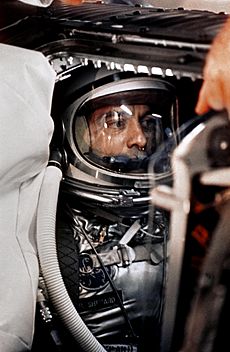
As of March 2011[update], Blue Origin had submitted the New Shepard reusable launch vehicle for use as an uncrewed rocket for NASA's suborbital reusable launch vehicle (sRLV) solicitation under NASA's Flight Opportunities Program. Blue Origin projects 100 km (62 mi) altitude in flights of approximately ten minutes duration, while carrying an 11.3 kg (25 lb) research payload. By March 2016, Blue Origin noted that they are "due to start flying unaccompanied scientific payloads later [in 2016]." On April 29, 2018, during its eighth flight New Shepard carried the Schmitt Space Communicator SC-1x, a three-pound device developed by Solstar that launched the first commercial wi-fi hotspot service in space and sent the first commercial Twitter message from space. NASA provided a part of the $2 million project's funding as a part of its Flight Opportunities program.
On 12 September 2022,18 NASA payloads were flying on NS-23 when an in-flight failure of the booster's main engine caused an emergency ejection of the payload capsule. The payload capsule landed safely and was recovered whilst the booster was lost.
Involvement with NASA Commercial Crew Development Program
Blue Origin received US$3.7 million in Commercial Crew Development (CCDev) phase 1 to advance several development objectives of its innovative "pusher" Launch Abort System (LAS) and composite pressure vessel.
In February 2011, with the end of the second ground test nearly complete, the company completed all work envisioned under the phase 1 contract for the pusher escape system. They also "completed work on the other aspect of its award, risk reduction work on a composite pressure vessel" for the vehicle.
See also
 In Spanish: New Shepard para niños
In Spanish: New Shepard para niños


